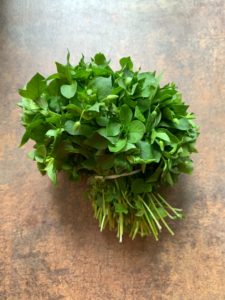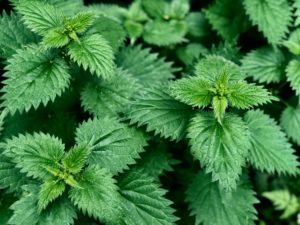Hunter gatherer
Spring into foraging with these handy hints and a great recipe from Naturopath, Sonya Byron.

The weather is warming, the wattle is blooming, it must be spring! This is a time of transition for body, mind and spirit, and it’s common to feel fatigued and stagnant by winter’s end. This is particularly the case if we’ve been hibernating for months, moving less than we’d ideally like to, and enjoying heavier foods.
A great antidote to the winter stodginess and a way to put a “spring” back into our step is to forage for some fresh wild herbs! This is the time of year traditionally known as the “hungry gap”, in which winter food stores are depleted, but spring crops are not yet ready for harvest. Nature, in her wisdom, therefore provided us with fresh wild herbs, such as chickweed, cleavers, dandelion, nettles and plantain. These herbs are full of nourishing vitamins, minerals and phytochemicals, and are regarded in traditional Western herbalism as having cleansing properties. So, there’s no need for harsh “detoxes” in spring, when we can simply forage our wild herbal allies instead.
A few of my favourite herbs to forage in early spring include:
Dandelion (Taraxacum officinale)
A member of the Asteraceae (daisy) family, and commonly regarded as a pesky lawn weed, the humble dandelion is an absolute powerhouse of nutrition! A 2014 study, assessing the nutrient density of different fruits and vegetables, classed dandelion leaves as the 16th most nutritious of all those assessed, beating “superfood” favourites, such as blueberries and broccoli (1).
The entire dandelion plant can be harvested, with the young and tender leaves especially delicious in spring. Eat these raw or cooked, add them to salads, soups or stews, sauté them with garlic, or make a delicious wild dandelion pesto (see below)! You can also dry the leaves for dandelion tea. The flowers can be added to omelettes, quiches, fritters and baked goods, and the inulin-rich root has prebiotic properties that support the health of the gut microbiome, and can be eaten like a parsnip, or dried and used as a coffee alternative.
Medicinally, dandelion is a bitter, tonic herb, traditionally prescribed to support the health and function of the digestive system, in particular the liver, gall bladder and kidneys. It’s also traditionally prescribed for oedema, hypertension, rheumatic conditions, and chronic skin disorders.
Nettles (Urtica dioica)
Nettles are another nutrient-rich wild herb, high in protein, vitamins, such as A and C, and minerals including iron, calcium, and magnesium. A member of the Urticaceae (nettle) family, the entire plant can be used for food and medicine, however, it’s the tender new leaves and soft stems that are best harvested in Spring (be sure to wear gloves to avoid their sting!). Look for nettles that are growing in deep shade for best flavour and texture.

Nettles must be cooked or dried prior to consuming, and are best used like spinach, added to soups and stews for the final few minutes of cooking, sautéed with garlic, made into pesto (blanch or steam first), added to omelettes, quiche and pastas, even baked as nettle “chips”. Try a combination of potato, sorrel, leek, and nettle for a delicious and nutritious seasonal soup!
In Western herbal medicine, nettles are a traditional blood tonic, and are often prescribed for allergic/atopic conditions including asthma, eczema, and hay fever. Try 3-4 cups fresh or dried nettle tea per day, with a little local honey added, if you’re prone to seasonal allergies. Nettles are also traditionally prescribed for warming the body and for conditions such as arthritis and rheumatism, and there are even stories of Roman soldiers rubbing their bodies with nettles to improve their circulation (ouch!).
Chickweed (Stellaria media)
Chickweed is a wonderfully versatile wild herb, especially beneficial for topical application to dry and irritated skin. Soothing and cooling, a chickweed poultice can be used to relieve the itch of dermatitis, psoriasis, and other chronic skin conditions, as well as to address minor burns, insect bites, and wounds. If you’d like to make a healing body oil, harvest handfuls of the herb, wilt for 24 hours, then infuse in extra virgin olive oil, gently shaking twice daily. Your oil will be ready to be strained after two to six weeks, and can then be used as is, or heated and combined with shea butter or beeswax to make gorgeous body butters and lotion bars.
A member of the Caryophyllaceae (carnation) family, chickweed is high in vitamins, especially vitamin C, and minerals such as iron, calcium and magnesium. The herb can once again be added to salads and sauces, sautéed with garlic, or added to soups, stews, omelettes, quiches, and pasta dishes. It’s also delicious added to a smoothie! Medicinally, in addition to its topical uses, chickweed is a demulcent herb traditionally prescribed in Western herbalism for gastrointestinal inflammation, irritation and ulceration.
Foraging how to, ethics and safety
Before you begin foraging, ensure it’s safe to do so! Wild herbs may bioaccumulate toxins, so areas that could be contaminated, such as the sides of roads, former agricultural or industrial sites, cemeteries, etc. are generally not suitable. Always ask permission if harvesting on private land, and check relevant laws/regulations.
Be sure that you have identified the herb you wish to harvest correctly, and if you have any doubt at all, do not consume it! If possible, forage with an experienced guide for the first time, or use a field guide or book, such as “The Wonderous World of Weeds” by Pat Collins, to assist you in correctly identifying your herbs. When consuming a new wild herb for the first time, try only a small quantity and wait for 48 hours before consuming more, in case of allergy or sensitivity.
Be mindful that others may wish to share the wild weeds too, in particular birds, bees and other insects! Recommendations vary, but I like to harvest no more than 10% of any herb in any one area, although if it’s a very prolific wild herb that you’re harvesting, such as dandelion or nettles, more may be ok.
Harvest mid-morning when the herbs’ oil content is optimal and dew has evaporated. Avoid rainy days if you plan to dry your herbs, as mould will be more likely to develop. Use sharp tools and handle your plant material gently. Garble (separate and discard poor quality/extraneous material) as you go to avoid additional handling later. Use a spacious cloth basket or bag for plants to be dried, and collect those being used fresh into a plastic bag to preserve their moisture content. Keep harvested material away from the sunlight and heat.
For dried herbs, dry as soon as possible in a well-ventilated room that is not too hot (under 40 degrees C). Lay the herbs in a single layer on old window screens or on muslin stretched over frames. Avoid multiple layers of herbs or bunching and hanging herbs upside down – this reduces air circulation, which can also result in mould. In warm Spring weather, with good air circulation and low humidity, most herbs will be fully dry within a week. Your herbs are ready for storage when they are dry and brittle, and can be kept in glass jars in a cool, dark location. Most aerial parts will keep for one to two years, and most roots and barks for two years. The smaller the particle size the shorter the shelf life, so store your herbs as whole as possible, and only grind or powder them when you’re ready to use them.
So now that you’ve foraged your spring herbs, why not try my wild dandelion pesto recipe? All of the ingredients in this recipe, with the exception of the dandelion leaves, are available in bulk at the Co-op. If you prefer not to forage for wild herbs yourself, you can still make this recipe using fresh basil, rocket, spinach or any of the other gorgeous organic greens available at the Co-op.
Wild dandelion pesto!
3-4 cups wild dandelion leaves (or substitute in whole or part, fresh chickweed or plantain leaves, or blanched cleavers or nettles. A mixture of wild spring herbs is also a great choice!)
1/2 cup pine nuts (or nuts of your choice)
1/4 cup Parmesan cheese, grated, or nutritional yeast
3-4 cloves garlic, minced
1-2 – 1 cup extra-virgin olive oil (buy the good stuff!)
1 Tbsp lemon juice or apple cider vinegar
1/2 tsp sea salt, finely ground
1/4 tsp black pepper, freshly ground
Place 1/2 cup of extra-virgin olive oil and all remaining ingredients in a food processor or blender and process until smooth. Slowly drizzle in the remaining olive oil and continue to process until desired texture is achieved. Add pesto to pasta or pizza, use as a dip for raw vegetable sticks, add to salad dressings and sauces, etc. Refrigerate leftovers and use within 3 days. This recipe also freezes well, so why not make a big batch and freeze it so you can enjoy your wild dandelion pesto year-round?
Happy foraging!

One of the Co-op’s in store practitioners, Sonya Byron, is a naturopath and yoga teacher in clinical practice at Lower Mountains Health & Healing in Blaxland. Prior to her career in natural health, she earned her living as the owner/farmer of Good Karma Farm, a sustainable two-acre organic farm producing 60 different vegetable and herb crops. She believes that fresh, healthy, home grown food is one of the foundations of good health, and she’s passionate about empowering people to care for their health (and to save money, time and the planet in the process) by learning how to grow and preserve their own food, and how to make their own simple herbal and nutritional remedies for common health complaints. For further information, visit Sonya Byron Plant Medicine at sonyabyron.com.au
(The information in this article is for educational purposes only and is not intended as a substitute for health care advice. Please consult your friendly local naturopath, herbalist or other health care practitioner for personalised advice, particularly if you have a diagnosed medical condition or take pharmaceutical medications).
(1) Di Noia J. (2014). Defining Powerhouse Fruits and Vegetables: A Nutrient Density Approach. Preventing Chronic Disease, 11:130390.


